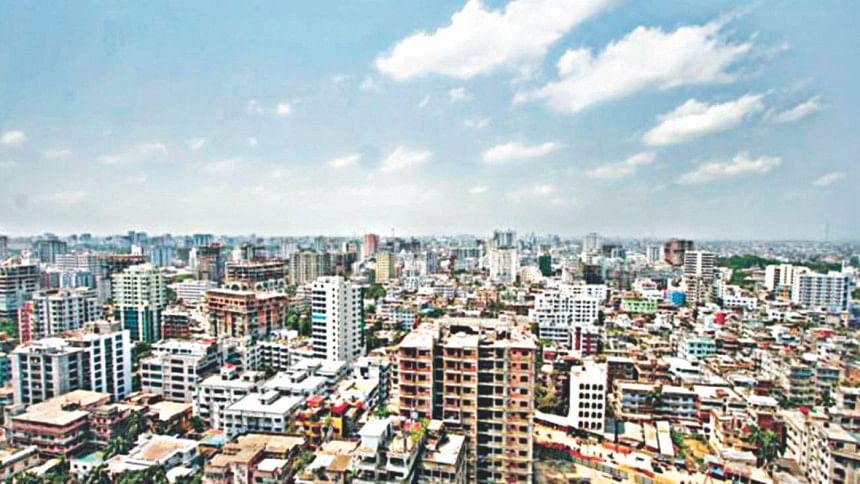Toward Great Dhaka: The value of planned urban expansion

The success of Dhaka as a productive, vibrant and resilient city is vital to Bangladesh's future. Home to 18 million people, Dhaka is the main hub of economic activity in the country, generating a fifth of national GDP and nearly half of all formal jobs. But with another 7 million residents expected by 2035, the issues that the city is already facing—congestion, flooding and messiness coming from poor access to services—need to be addressed urgently. How can the city respond to these challenges to put Dhaka on the path to a prosperous future?
One unique opportunity is the development of East Dhaka. This large tract of low-lying land is in a prime location, close to the current heart of the city. This is driving demand for the development of the area, but the current trend is toward haphazard developments. Land is acquired, and filled with sand, and there is little in the way of transport infrastructure or service provision. Before long, East Dhaka may look like the messy areas in the west of the city. But with good planning today, East Dhaka could become a modern hub of economic activity, with productive jobs and high-density modern housing that will create higher living standards for generations to come.
In a report just published by the World Bank, we analysed the opportunities of East Dhaka. Using modelling techniques at the forefront of economic research, we simulated four scenarios for the area, ranging from a business-as-usual approach to a full strategic scenario. The economic model captures the decisions of households, firms and land developers in Dhaka. Dhaka's residents want productive, good-quality jobs, and to spend as little time as possible commuting to and from work on the city's roads. But they are constrained in their choices by their wages, rents and a congested transport network. Firms want to be accessible to their consumers, suppliers and workforce, and also to benefit from locating near other firms within the city. Together, these different groups interact, creating the city layout that we see today.
Under the business-as-usual scenario, the city continues to develop as now, with some transport investments completed and an ever-growing population. East Dhaka becomes increasingly developed using sand-filled land, although this is of low quality and subject to earthquakes and flooding. The development is largely unplanned and haphazard and unlikely to deliver a modern, efficient city.
In the second scenario, an eastern embankment would be built along the Balu River. A vast amount of land would then become less vulnerable to flooding, thereby increasing the quality and amount of land available in East Dhaka for development. Some households and firms would move in, but there remains a risk that without planning and the provision of good public services, this will be messy, irregular residential developments like those seen in parts of West Dhaka today. Manufacturing firms will also be likely to move in; as the most land-intensive of economic sectors, they will value the abundance of land.
Under the third scenario, the benefits of the embankment are much larger if it is accompanied by the construction of more transport links, including two branches of mass rapid transit and one of bus rapid transit. This would encourage more households to move into the area, with good links to the rest of the city and beyond.
The fourth strategic scenario envisages extra policies designed to attract business service firms to relocate into a specific area of East Dhaka and the provision of extra amenities to make East Dhaka an attractive choice to live in. These policies are actually some of the hardest to implement, and may include a desirable tax environment and the removal of red tape to encourage firms. Firms often choose to cluster together, locating, for example, in the high-density Gulshan area despite the high rents. To create a new cluster of firms in East Dhaka, the business environment there has to be good enough for the firms to shift the economic centre of gravity of the city toward East Dhaka. The simulations suggest that the costs of doing business in East Dhaka should be reduced to 80–90 percent of the costs in Central Dhaka to encourage high-value-added firms to move into the area, generating productive jobs. Good amenities, including schools, health centres and protected green spaces, would encourage residents to move in, allowing households to live near their place of work and limiting the time spent commuting.
A strategic approach to the development of East Dhaka has the potential to make this area a vibrant hub of economic activity. Some 2.3 million jobs could locate in East Dhaka, nearly a million of which are in the high-value-added business services sector. High-density housing could be home to over 6 million people, proving a good living environment. Importantly, some of these people would otherwise be living and working in Central Dhaka; the strategic approach would partially relieve the congestion and pressures on the rest of the city, creating a more balanced pattern of development.
The returns to such a project would be high. By 2035, the total output of Greater Dhaka is expected to reach USD 196 billion. While building the embankment alone could create an extra USD 20 billion in GDP, the full strategic approach could boost the city's GDP by a further USD 57 billion. Under the business-as-usual scenario, Greater Dhaka's income per capita is expected to reach USD 8,000 by 2035. Under the strategic scenario, this could increase to as much as USD 9,200. With East Dhaka as its engine of growth, this ambitious vision would move Dhaka up in the global ranking of cities, making it more prosperous than cities such as Lima, Peru and Xi'an, China.
The opportunities offered by East Dhaka are vast. With good planning and implementation, the area could lead Greater Dhaka into the future as a modern, productive city, providing jobs and homes for millions with a better quality of life, and generating revenue to sustain the city and propel the nation's growth as a whole.
Anthony Venables is Professor of Economics and Director of Centre for the Analysis of Resource Rich Economies, University of Oxford, and Julia Bird is Postdoctoral Research Fellow, University of Oxford.





Comments